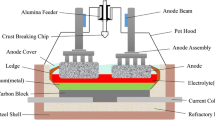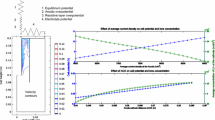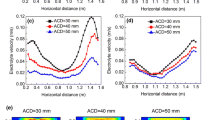Abstract
This article illustrates the role of anode design in increasing the energy efficiency of advanced Hall-Héroult cells. In this study, a “novel” anode that promotes the removal of gas bubbles, generated by the anodic reaction, from the interelectrode gap has been simulated. The efficacy of this anode has been judged with the help of electrolyte flow and interpolar resistance measurements in the horizontal, near-horizontal, and near-vertical electrode configurations. The experimental arrangement was similar to that used in Part I, the companion article. Velocities were measured with a laser-Doppler velocimeter (LDV). Both velocity and interpolar resistance measurements indicate the superiority of this novel anode over a flat anode. Use of this novel anode (vis-à-vis the flat anode) should lead to a reduction (approximately 40 Pct) in interpolar resistance at current density levels used in the industry. Furthermore, electrolyte flow in the anode-to-cathode gap (ACG) is uniform, thereby minimizing the possible problem of reoxidation of aluminum which might be present in cells operated with flat anodes. This study also highlights the major drawbacks of advanced Hall cells operated in the near-vertical configuration: existence of recirculating flow and very high volume fraction of bubbles near the top of the ACG. Both of these factors could lead to increased oxidation of aluminum and, therefore, to reduced current efficiency. Finally, comparison of results with Part I suggests that maximum energy efficiency should be obtained in retrofitted advanced Hall cells operated with this novel anode in the near-horizontal electrode configuration.
Similar content being viewed by others
References
R. Shekhar and J.W. Evans:Metall. Mater. Trans. B, 1994, vol. 25B, pp. 333–40.
J.W. Evans and R. Shekhar:Physical Modeling of Bubble Phenomena, Electrolyte Flow and Mass Transfer in Simulated Advanced Hall Cells. Report to DOE and addendum, Subcontract No. C87-101226-002, University of California, Berkeley, CA, 1990 (DOE-ID-10281, and DOE-ID-10281-ADD).
R.C. Dorward and J.R. Payne:An Evaluation of a Titanium Diboride Composite Material as Cathode for Low Energy Alumina Reduction Cells. Topical Report DOE/CS/40215-2, Kaiser Aluminum and Chemical Corp., Oakland, CA, 1985.
R.C. Dorward and J.R. Payne:Development of Monolithic Titanium Diboride Cathodes for Retrofit Hall Cell. Report DOE, DE-AC07-76CS40215, Kaiser Aluminum, 30 June 1976–30 June 1983.
Author information
Authors and Affiliations
Rights and permissions
About this article
Cite this article
Shekhar, R., Evans, J.W. Physical modeling studies of electrolyte flow due to gas evolution and some aspects of bubble behavior in advanced hall cells: Part II. Flow and interpolar resistance in cells with a grooved anode. Metall Mater Trans B 25, 341–349 (1994). https://doi.org/10.1007/BF02663383
Received:
Issue Date:
DOI: https://doi.org/10.1007/BF02663383




